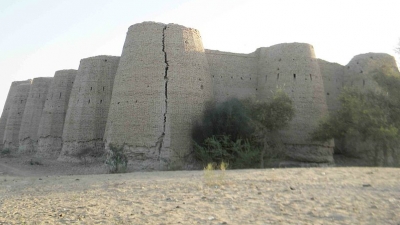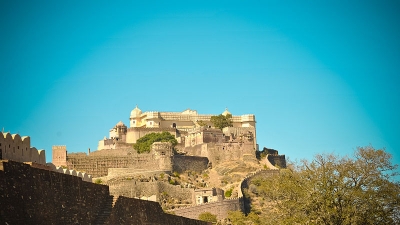Chittorgarh Attractions - Tourist Places To Visit In Chittorgarh
-
01Chittorgarh Fort
 + Read More
+ Read MoreChittorgarh Fort is a mighty and splendid structure depicting the glorious past of Chittorgarh. It is a major tourist attraction of the city. According to a folklore, the Mauryans built the fort during the 7th century. This magnificent structure rests over a 180 m high hillock and sprawls over an area of about 700 acres.
It is an epitome of architectural mastery that has survived through several devastations in the past. The way to the fort is not easy; one needs to walk a mile passing through steep and winding thoroughfare to reach the fort.
The fort has seven huge iron spiked gates that are named after Hindu deities. The magnificent palaces of Rani Padmini and Maharana Kumbha are situated inside the fort, along with many beautiful temples. There are several water bodies inside the fort that are fed by natural catchments or rainfall.
-
02Vijaya Stambh
 + Read More
+ Read MoreVijaya Stambh or Victory Tower is a popular tourist destination of Chittorgarh. Maharana Kumbha constructed the tower in the year 1440 AD. This artistic masterpiece stands as a symbol of victory of the kingdom over Mohammed Khilji, the impostor.
The tower is about 37 m in height and has 9 floors. Pictures of Hindu deities beautify the walls of the tower. Impressive sculptures depicting stories from the Hindu epics, the Ramayana, and the Mahabharata enhance the exquisiteness of the tower. The magnificent view of the entire city can be enjoyed from the top of the tower.
-
03Kalika Mata Temple
 + Read More
+ Read MoreKalika Mata Temple, constructed in the 8th century, is believed to be one of the oldest temples of the region. King Bappa Rawal of Sisodia Dynasty built the temple as a Sun Temple. However, during the 14th century, Maharana Hamir Singh established an idol of Kalika Mata inside the temple.
Since then, it became popular as the Kalika Mata Temple. Goddess Kalika symbolises valour and power and is believed to be the protector of Chittorgarh. The Kalika Mata Temple has a beautiful architectural design with several magnificent carved pictures and sculptures. The annual festival attracts a large number of devotees who come to seek blessings of Kalika Mata.
-
04Gaumukh Kund
 + Read More
+ Read MoreGaumukh Kund is a sacred water body situated on the western part of the famous Chittorgarh Fort. 'Gaumukh' literally means the 'mouth of a cow'. The water flows by the cracks in the rocks and in due course, falls into the reservoir.
Travellers are allowed to feed the fishes of the reservoir. The Rani Bindar Tunnel located near this reservoir is also a noted attraction. According to a legend, this tunnel leads to an underground chamber, where Rani Padmini of Chittorgarh performed 'Jauhar'.
-
05Maha Sati
 + Read More
+ Read MoreMaha Sati is a sacred place, wherein the rulers of Udaipur were cremated. The prime attraction of the place is the Gangodbhawa Kund, a natural water reservoir, which according to a belief, has been formed by a tributary of the river Ganges.
The underground tributary emerges in the form of Ahar river out of which the kund is created. According to a folklore, the water of the kund is as pious as that of the river Ganges. There is also a temple of Lord Shiva, situated in the vicinity of the temple.
-
06Rana Kumbha Palace
 + Read More
+ Read MoreRana Kumbha Palace is a historical monument where the Rajput King Maharana Kumbha spent his royal life. This magnificent palace was built in the 15th century and is considered to be one of the finest structures in India. It is an epitome of the Rajputana architecture and is very popular among tourists.
The palace is believed to have underground cellars where Rani Padmini along with other women of the province performed 'Jauhar' (honorary self-immolation to save oneself from being dishonoured at the hands of the enemies). The palace has an ancient temple nearby which is dedicated to Lord Shiva. Every day, a light and sound show is organised for tourists in the palace complex.
-
07Kirti Stambh
+ Read MoreKirti Stambh, also known as the ‘Tower of Fame’, is a 22 m high, seven-storey tower. It is dedicated to the first Jain Tirthankara, Adinath. The architecture of the Kirti Stambh is of Solanki style with balconies and beautiful carvings on the wall.
On the walls of the stambh, visitors can see figures of the Jain Tirthankaras. Furthermore, one can see the magnificently carved sculpture of Lord Adinath on the second floor. The seventh floor of the temple offers panoramic views of the splendid Chittorgarh City.
-
08Kumbha Shyam Temple
 + Read More
+ Read MoreKumbha Shyam Temple is dedicated to Lord Vishnu, who is worshipped here as Varaha (His boar incarnation). The shrine was constructed by Maharana Sangram Singh I, upon special request of his daughter-in-law, Meera.
It is located near the Kumbha Temple inside the Chittorgarh Fort. The architecture of the temple resembles that of Kalika Mata Temple, also located in Chittorgarh. The beautiful shrine possesses a pyramidal tower, and a tall roof, while the floor has footprints of Meera's Guru, Saint Ravidas of Varanasi.
Walls of the temple have beautiful images of several Gods and Goddesses. Devotees throng the place, owing to its serene atmosphere, religious significance, as well as the legends associated with it.
-
09Archaeological Museum
 + Read More
+ Read MoreArchaeological Museum of Chittorgarh is located at the eastern end of the Banbir-ki-Diwar. It is an important tourist attraction. People with a special interest in history would love the place. The museum houses a large collection of historical artefacts, paintings and sculptures which were either made during the Rajputana rule or were built later to immortalise the brave Rajput Kings.
Some items of the museum belong to the Maurya and Gupta period. These artefacts depict different aspects of the Buddhist and Hindu culture. The museum also preserves various articles discovered while excavating these ancient sites.
-
10Padmini's Palace
+ Read MorePadmini’s Palace was the residence of the brave and beautiful Rani Padmini. The palace is located inside the magnificent Chittorgarh Fort and depicts the story of courage and grace of Rani Padmini. A beautiful lotus pond is situated near the palace. It is believed that this was the place where Sultan Alauddin Khilji got a glimpse of the reflection of the beautiful Rani Padmini.
Her eternal beauty overwhelmed the Sultan and his desire for the Rani eventually led to a battle. The palace has marvellous architecture and pictorial surroundings that add to its charm. The Neelkantha Mahadev Temple, dedicated to Lord Shiva, is located nearby.
-
11Meera Temple
+ Read MoreMeera Temple is a shrine associated with Meera Bai, who was a Rajput princess. She gave up all the luxuries of royal life, and spent her whole life in devotion to Lord Krishna. Meera Bai had spent her life singing bhajans and songs in praise of Lord Krishna.
The Meera Temple is an excellent specimen of the Rajputana style of architecture. It is situated close to Kumbha Shyam Temple. North Indian style has been followed while constructing the temple. It has four pavilions in the open gallery encircling the shrine. Several striking and lively paintings of Meera and Lord Krishna adorn the interiors of the temple.
-
12Nagri
 + Read More
+ Read MoreNagri, a noted township during the Mauryan reign, is located at a distance of 11 km from Chittorgarh. It rests on the banks of the river Bairach. Earlier, the town was known by the name 'Madhyamika' and it flourished well from the Mauryan to the Gupta period.
Over the years, excavations have revealed several interesting facts about this place, like its association with the Hindu and Buddhist culture. During excavations, a stupa, decorated with terracotta tiles has been discovered from this historical site.
-
13Bassi Wildlife Sanctuary
 + Read More
+ Read MoreBassi Wildlife Sanctuary, situated near Bassi Village, sprawls over an area of 50 sq km. Bounded by the Vindhyachal Ranges in the west, the region presents a picturesque landscape to the pleasure of nature lovers. This place is an exciting destination for wildlife enthusiasts due to abundance of wild animals like panthers, wild boars, mongoose and antelopes in their natural habitat.
The reserve also attracts various migratory birds. Orai Dam and Bassi Dam located within the sanctuary are also prominent attractions of the place. It must be noted that visitors are required to seek prior permission from the District Forest Officer of Chittorgarh to visit the sanctuary.
-
14Sitamata Wildlife Sanctuary
 + Read More
+ Read MoreSitamata Wildlife Sanctuary sprawls over the Aravalli Mountains and the Malwa Plateau. The sanctuary is filled with thick deciduous forests, which happen to be the only forests with such a large number of teak trees. Besides bamboo, salar, amla and bel, almost half of the trees are teak trees.
The rivers such as Jakham and Karmoi pass through the sanctuary. There is a dam built over the Jakham river, which caters to the irrigation needs of the natives. Animals like leopards, hyenas, jackals, wildcats, porcupines, spotted deer, bears and four-horned antelopes can be sighted inside the sanctuary.
Flying squirrel, an interesting nocturnal creature can be seen gliding between the trees at night.This place also holds mythological importance as it is believed that Sita, the wife of Lord Rama, stayed in Saint Valmiki's Ashram here during her exile.
-
15Sanwariaji Temples
 + Read More
+ Read MoreSanwariaji Temples are counted among the prominent religious centres of Chittorgarh. These are dedicated to Sanwariaji, an incarnation of Lord Krishna. These shrines are highly revered by Hindu devotees, especially in North India. Two of these temples are located on the National Highway 76, while the third shrine lies in the Bhadsoda Village, 1 km from the Bhadsoda Chouraha on NH 76.
There is an interesting tale behind these temples. It is believed that 250 years ago, a cowherd boy called Bholaram Gurjar dreamt of 4 statues of the deity buried at Bhadsoda. The place was dug, and the statues were recovered, but one of them got destroyed in the process and was reburied.
The three remaining statues were installed at three temples and worshipped as Sanwariaji. The statues are beautiful and depict Lord Krishna playing the flute. Devotees throng the shrines, which are renowned for the magical blessings of the deity.



 Click it and Unblock the Notifications
Click it and Unblock the Notifications








